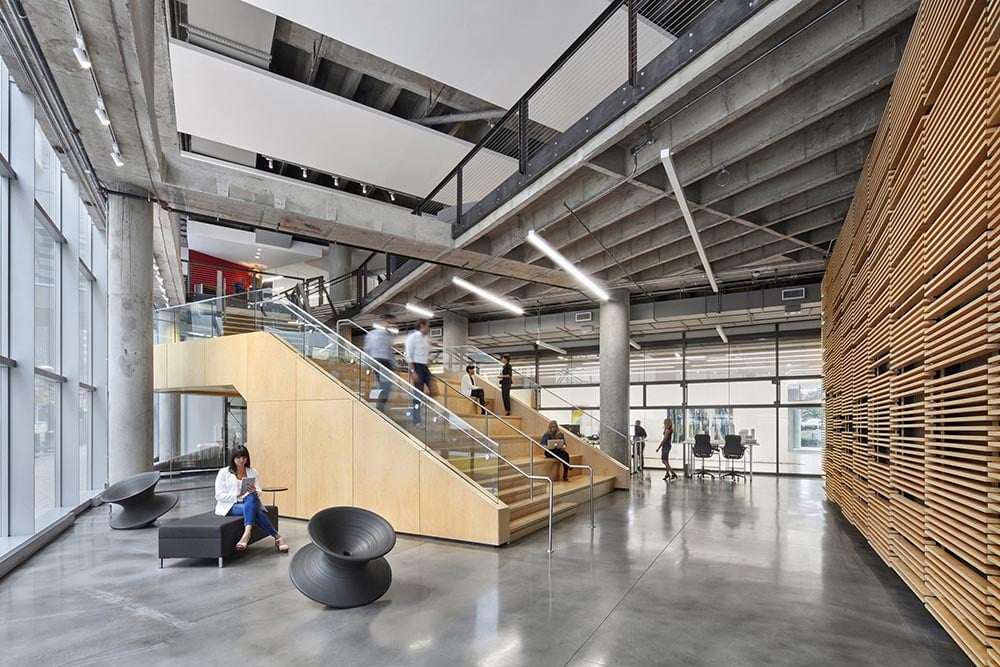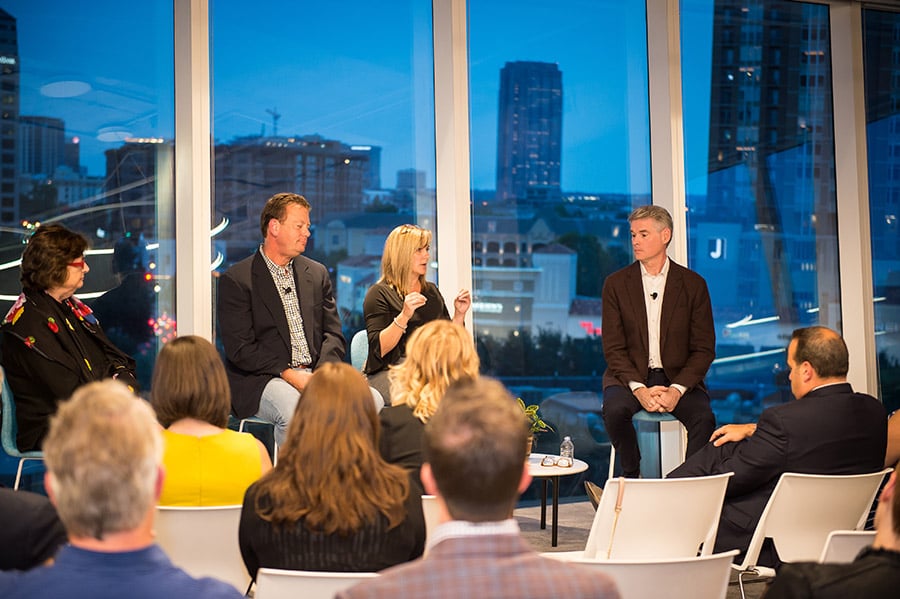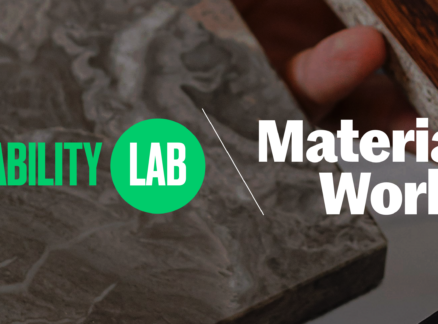
October 25, 2017
A Healthy Return: The Business Case for Wellbeing in the Workplace – Part 3
In the third installment of a 4-part event series, Haworth hosts a Q&A with an expert panel on designing offices that support today’s workers.
Rethinking the workplace with millennials in mind has been a hot topic in design circles for nearly a decade. But if you look closely, the rethink goes deeper than that. New studies show that while millennials may have been the catalyst for change in offices across the country, organizations are taking the opportunity to look at the wellbeing of all of their workers in order to design a workspace that is productive and uplifting. Susan S. Szenasy, our director of design innovation, sat down with a panel of design experts at the Haworth showroom in Dallas, Texas to learn more about the business case for wellbeing and how improving office design can limit employee turnover and improve performance. The panel included Dave Clark, director of workplace solutions at Capital One, Beck Johnson, global workplace research specialist at Haworth and David Lubin, associate principal at HKS. What follows is a transcript of that conversation, edited for clarity by Bailey McCann.
Susan S. Szenasy (SSS): Dave, let’s start with you. Can you tell us a little about your group at Capital One and what you see unfolding before you?
Dave Clark (DC): Sure, in my little sandbox up in Plano, we’ve got a number of generations in the workforce. So, our space is in continual evolution. The oldest buildings on our campus are roughly nine years old. What Capital One has embraced is a rapid churn type of scenario where literally, nothing in that original building is still there. All the furniture, fixtures, furniture, lighting, the carpets, finishes, everything continually evolves over time and we don’t do it willy-nilly. We want to build and leverage a culture and that also evolves over time as new generations come into the workforce. For example, we opened a new building in March that has a 32-foot slide. We have bikes that you can ride around the campus. When you’re looking to attract millennials you want to make it fun to work here.
SSS: What made you decide to include those elements in the space?

DC: It’s about providing a variety of different environments for the associates to work in. So, whether you want to work indoors or outdoors, or maybe you want just a little mental relief. It’s hard to have a bad time going down a double helix slide, I’m just telling you.
SSS: David, let’s turn to you. From the interior design perspective, what are you seeing among your clients? What are some of the most interesting things that they’re trying to do?
David Lubin (DL): Each client is different, so I would say that there is not a one size fits all. We were talking earlier about how good design equals good business. That’s true, but I think in a lot of ways, the design aspect has exploded. It’s not just about space – it’s an experience. We’re talking about how to address not only how people sit and work and collaborate, but how they actually mentally get through the day.
SSS: That’s really interesting to me because you’ve hired the “ologists” – the people who study human behavior, health issues, mental health. That’s a shift from even five years ago, in terms of how much different thinking is going into design. Can you talk a little bit about that for your firm specifically?
DL: Sure. Actually, I think we have a very unusual group. We’ve got those anthropologists actually in our firm. We’ve hired them so it’s no longer just a design firm. We bring a lot of that thinking to every project that we do. We’re very fortunate that we have a lot of great minds. We partner with universities to do a lot of things. We are very fortunate to do that work in-house and bring it back to our clients.
SSS: Beck, let’s turn to you. You’re working on a lot of design research and strategy. Can you give us the current wisdom on what we know about ourselves in terms of our work lives?
Beck Johnson (BJ): I think what’s exciting for me is that I see this push towards humanizing the workplace. There are certain design elements that convey that a company values its employees and that contributes to their happiness. Take the slide Dave mentioned, it says we want you to take a break every so often. We’re not saying you need to go down the slide five times a day and mandate it, right? It’s there and we’re playful and we want that feeling in our workplace.
SSS: I’d like to go back to Dave for more perspective here. Can you talk about the other programs that you devised for your employees?

DC: In our Plano campus, we are basically supporting two pillars of the company – one is doing home loans and the other is car loans. If you look at the current moment around hurricane Harvey and flooding as an example, we decided to plan for what individuals are dealing with when they get a loan. Our leadership team established a series of empathy rooms where we brought in grief counselors for our associates, so if you’re starting to feel overwhelmed by all of the tragedy, you have someone to talk to.
SSS: It seems like those decisions are corporate decisions. How do those happen?
DC: We’re very fortunate that the leadership that we have on the Plano campus, is very attuned to the associate population. We’re trying to support our end customers. In order to do that, we need to empower our associates to be that frontline voice and they are going to need some help. So it really starts at the very top of our organization here locally.
SSS: David, tell us about your experience with these decisions. Are there some things that companies just won’t spend for? Or does it depend?
DL: Everybody does something and it’s very different. I think the cultural aspect of it is huge. If it’s a top-down decision, it’s always more successful. But in a lot of cases, we’re seeing some grassroots things that are bubbling up and really enlightening the leadership.

SSS: Dave, how do you make decisions that work for all of the generations in the office? I’m not a millennial, I don’t think I’d go down the slide.
DC: For us, culture is key. It drives everything we do. That means we try to do the right thing for everybody. We also have a very aggressive change management program to make sure that the office works for everybody.
SSS: David, from the interior design perspective, how do you do architecture and design for all generations?
DL: We actually design for what we call “perennials” and that means everyone in the office, not just the millennials. We try to put together multiple types of spaces to allow people to work the way they want to and socialize the way they want to. That way no one feels left out.
SSS: Beck just to add you in here, going back to how people bring their lives into work now, are you also studying how the body works in office spaces? How can design support the human body in all of its activities?
BJ: Yes. There are really great things that happen when we’re allowed to work the way we work best. We’re looking into broad categories like cognition and focus. We understand that if you’re in a space for eight hours you’re not working the same way for all eight of those hours. You have to design for the generations but also activity.

SSS: David, how many of your clients bring these kinds of standards to their projects?
DL: The most successful projects and clients we work with are the ones with that crystal clear vision. Full disclosure, we’re going through some of this just within the corporate interiors group at HKS. There’s a fundamental, chromosomal culture that I think we have as a firm that we’re actually trying to stretch out across office design. A lot of our clients though, not so much. So we have to work with our clients on defining culture and the project goals.
SSS: Let’s explore that idea further. What’s the business case for wellbeing in the office? Dave, can you talk about how Capital One sees it?
DC: Let’s understand, you’ve still got to make a living but if you don’t want to have a 40% annual turnover rate, you have to find a way to incentivize and get to people to buy into your culture, to buy into your mission. You have to have a workplace that people feel satisfied in. That’s where the design comes into play. So we spend a lot of time on culture and making the right decisions.
SSS: Beck, can you talk a little bit about your research in this area in terms of how work gets done in a space?
Beck: Well, I think a lot of it ties into the whole notion of innovation. I think organizations signal their culture through design. If you want your organization to collaborate, you have to allow time and space for that to happen. It’s also about connecting organically. If you have older generations in the workplace you have to think about passing on the tribal knowledge. How can you get those people interacting? There are design cues that will do that.
SSS: So ultimately, what we’ve learned here today is that design today is about thoughtful collaboration. It’s about having culture and design work together so that we are measuring purpose and benefit, not just how many pieces of paper move through the office. I think those are really important lessons to learn because that creates a different view of culture and design.

This Q&A is the third installment in our four part panel series “A Healthy Return: The Business Case for Wellbeing in the Workplace.” To catch up on previous installments see Part 1 and Part 2.
Join us next month for our final event in Washington D.C. on November 14. Register here.





